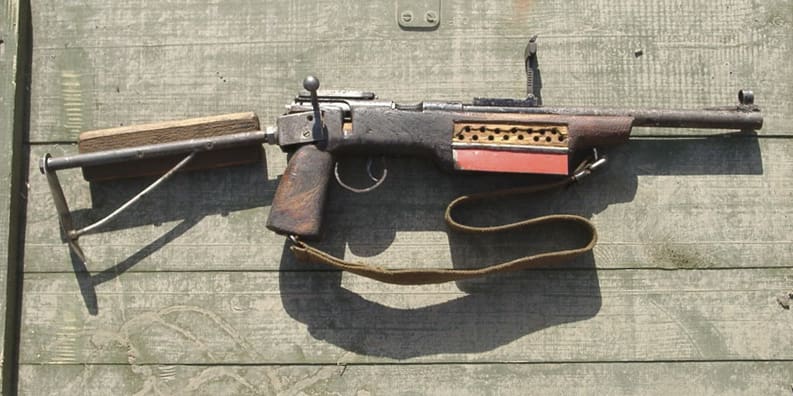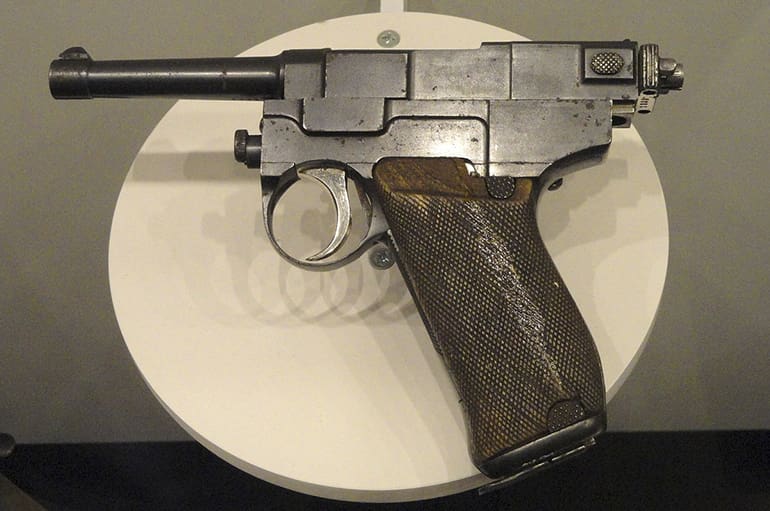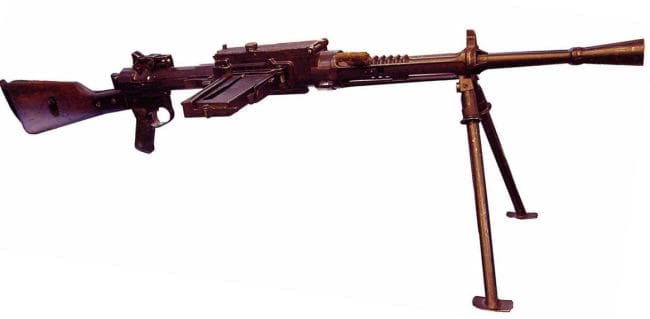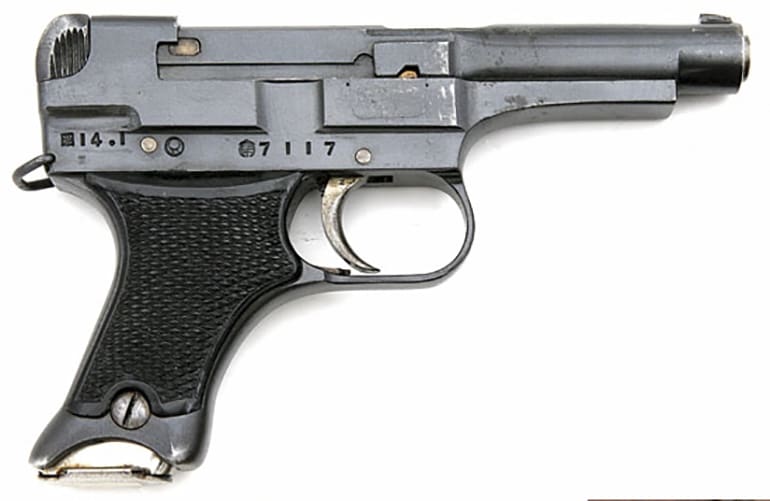Reader A. E. Johnson writes:
Ever since the dawn of mankind we’ve been trying to kill one another. But it was only with the advent of gunpowder that we got really good at it.
Firearms have existed for centuries, and have been constantly evolving to become ever more efficient at what they do. Yet for every new, awe-inspiring innovation, there comes another not-so-amazing design. One that makes you shake your head that it ever managed to be produced. Sometimes this is due to poor quality materials, rushed production lines, or just plain old or bad designers who had no idea what they were doing.
So while it’s been difficult to narrow them down, here’s a list of some of the worst modern firearms designs (and by “modern” we’re looking at roughly the last century) ever put into production.
To be clear, we’re not including designs that were intended to be cheap and crappy from the start.

We’re looking at you here, Saturday night specials.

Also, homemade, improvised, workshop-made or “one-off” weaponry is off the table, too. We’ll just be concentrating on production firearms here.
So without further ado, here are the five worst modern production firearms ever made . . .

5) Gyrojet
Manufacturer: MB Associates, USA
The Gyrojet series — which looked like it was assembled with parts from an Erector Set — was developed by MBA in the 1960’s and was basically a handheld rocket launcher, firing 13mm propellant-driven projectiles. Various light machine gun and rifle variants were also planned, but few ever made it to the prototype stages. Despite this, there were cases of the pistols being used by U.S. soldiers in Vietnam, with limited success.
Differing from most “traditional” firearms, the velocity of the Gyrojet rockets would actually increase after leaving the barrel. This may have been a plus when firing at distant targets, but made the Gyrojet lousy at close range…which, funnily enough, is actually an important requirement for a handgun.
The Gyrojet also featured a restrictive six-round magazine, had a clumsy reloading process, and featured exposed vent ports which would also interfere with loading and firing the gun’s unique projectiles. Given the fact that existing pistols already did a much better job (ie, actually had the ability to cause damage to targets within 10 feet), MBA eventually folded along with the Gyrojet design.

4) Glisenti Model 1910
Manufacturer: Metallurgica Brescia gia Tempini (MBT), Italy
The Glisenti Model 1910 has mainly been included on our illustrious list because it had an awful tendency to quite literally fall apart. That feature made Erector Set and Lego guns look like better alternatives, as at least they wouldn’t collapse quite so often when the trigger was pulled.
Being one of the first semi-auto handguns accepted for frontline service, the M1910 was introduced in (surprisingly) 1910 and saw use during World War I, all the way to World War II. For some reason.
This was a time when many militaries were starting to make the transition from larger caliber revolvers that were well-known and trusted by soldiers to new, untested semi-automatic handguns. While its 9mm rounds were similar to the renowned German 9mm parabellum cartridges, Glisenti ammunition had to have a reduced powder charge. The Glisenti simply couldn’t handle the higher pressures, as it had been flimsily engineered and lacked structural integrity.
It also had one particularly dubious feature; a takedown screw located on the front of the frame, designed to allow the left side of the gun to be exposed, and the gun disassembled. Unfortunately, the rickety design of the handgun often led to the screw loosening. That resulted in the frame and receiver assembly coming apart at inopportune moments. Also, if a poor Italian soldier who was issued a Glisenti made the mistake of loading it with more powerful 9mm parabellum rounds, there was a high likelihood that the gun would explode.
Fortunately, Italy could fall back on other domestic gun makers that actually knew what they were doing. The sorry Glisenti was eventually replaced with the excellent Beretta M1934. But that doesn’t mean we’re finished Italian guns just yet . . .

3) Breda Modello 30 Light Machine Gun
Manufacturer: Breda Meccanica Bresciana, Italy
Italy has produced many of history’s greatest minds and consumer products throughout its long history. Ferraris, opera, Armani suits, Leonardo da Vinci, and gelato come to mind. The Breda Modello 30, however, was not one of those things.
The Breda was a light machine gun used by Italy through World War II and utilized many unique design notes. One of them was a fixed magazine that opened via a hinge. One feature of this was that, if ever the gun’s fixed magazine or its hinge were damaged, the Breda became unusable.
As you may know, World War II revolved less around “pink fluffy clouds” and more around “shit-encrusted hell-holes” and this proved to be problematic for this delicate Italian lady. In order to “help” the extraction of spent ammunition casings, a small lubrication device was built into each Breda. It oiled each round as it entered the firing chamber.
Combine that design with the many exotic locales the Breda found itself in (the deserts of North Africa, the Balkans, Greece) and fairly soon sand, dirt, dust and other debris was attracted to the well-oiled internal mechanisms. That resulted in frequent jamming unless the weapon was kept meticulously clean.
Not only that, but due to the closed bolt design, it wasn’t able to gain the benefits of cooling air circulation found in open bolt weapons. In the heat in North Africa, this mechanical issue sometimes caused rounds to prematurely “cook off” (fire unintentionally when the trigger wasn’t pulled) potentially killing or injuring the gunner…or any other Italian unlucky enough to be standing in front of the barrel at the time.
Also, the fixed-hinge magazine mentioned earlier had a slot at the top to allow the gunner to see how many rounds were left. It also was a great way to answer the question, “How many ways can we find to allow dirt to get into and screw up this gun?”

2) Type 94 Nambu Pistol
Manufacturer: Nambu Rifle Manufacturing Company
As a Japanese World War II era pistol that fired 8mm Nambu rounds, the Type 94 was underpowered, cumbersome, awkward to use and disassemble, and very unsafe for the user.
The Type 94’s initial design was already flawed, but was made worse by interference by the Japanese Ordnance Department. The magazine size was a paltry six rounds, and the useless blade sights made it very inaccurate. Slipping late war production standards as Japan scrambled with limited resources further added poor workmanship and quality problems.
The main feature that puts the Type 94 on our list was its tendency to fire when you didn’t want it to. The external sear bar projected from the sides, and if it was depressed as little at 2mm, it could go bang. There are also claims that this little feature may have been used by IJA officers as a final “suicide shot” when handing the pistol over when captured. Scary stuff, indeed.

1) Chauchat light machine gun
Manufacturer: Gladiator and SIDARME, France
Officially called “Le Fusil Mitrailleur 1915 CSRG” by France, and “a piece of merde” by likely everyone else, the Chauchat was arguably the most disastrous production firearm of modern times. The Gladiator factory in Paris (where the majority of the manufacturing was done) compiled an extensive rap sheet of shoddy workmanship where these guns were concerned, including use of substandard materials, improper heat treatment and myriad other factors that helped to put the Chauchat at number one on our hit parade.
Introduced during World War I, the woeful Chauchat was immediately tested in one of the most inhospitable environments of the last century — the mud-filled trenches of the Western Front. The Chauchat provided the role of a “light machine gun” which was a concept very much in its infancy during the Great War.
Designed to provide automatic fire, it would jam frequently and overheat, sometimes after only 100 rounds being fired. The firing mechanism would then lock in place for up to 10 minutes until the Chaucat cooled down. The long recoil mechanism also made it awkward to shoot. The poorly-made sights usually shot too low and to the right, which didn’t exactly lead to great accuracy. It also had a flimsy, crappy bipod. Seriously, there have been Happy Meal toys that were better made.
One of the worst flaws was its flimsy magazine, which had a measly capacity for a machine gun of only 20 rounds. The magazine springs usually weren’t strong enough to actually push new rounds into the chamber, so most Chauchat gunners “short-loaded” their mags (only loading 18 or 19 rounds) for increased reliability. Even then, first round jams were disturbingly common.
Even worse, the magazine was almost completely open on one side and exposed the gun and its ammunition to all the mud, slime and dirt and filth that the trenches could provide. In addition, the magazine feed lips were easily bent and the entire magazine could be easily crushed or deformed, rendering one of the most integral parts of the weapon useless.
After America decided to join the party over there, France was kind enough to manufacture Chauchats in .30-06 caliber for U.S. troops. And by “kind” we mean “provide even more crappy guns made even worse than had been before.” The new Chauchats suffered from incorrect chamber measurements for the American round, as well as all the above-mentioned design issues. American ordnance inspectors rejected as much as 40 percent of the .30-cal. Chauchats, and even then, the .30-’06 Springfield cartridge overpowered the flimsy weapon.





Those little .22 short revolvers in the second picture. I used to see those as prizes in carnival booths when I was a kid. Piss poor quality. The one I had fired about 6 shots and then after every shot you had to manually push the trigger forward.
But then you could mail order guns to your house then, too.
“But then you could mail order guns to your house then, too.”
We just might be able to do so again.
I could see a federal judge so pissed-off at the Leftist Scum ™ that he/she kills the ’68 GCA… 🙂
This is a fun article, but more on the historical side.
I’d like to see one for today’s production makes/models. As in, which ones to *avoid* if you’re looking to buy. That would prompt a lengthy comment section, fer sure.
Where to begin. Sccy, Hi point……….
HiPoints are ugly as sin, but they tend to go *Bang* with boring regularity. And they don’t blow up in people’s hands.
The only way they could hurt the owner is if an irate someone rams it up the owner’s backside in a fit of rage.
I would hardly put the modest HiPoint in a worst-gun category…
‘But it was only with the advent of gunpowder that we got really good at it.’
Genghis Khan says ‘hold my beer’.’
“Genghis Khan says ‘hold my beer’.’”
And the Hmong… *snicker* 🙂
Stalin said why go through so much trouble. Just send them to bed with no food.
“In the good ole USSR we didn’t have KFC, we had KGB. Because when you’re Russian for food there’s no time for Stalin.”
-Valdmir Putin, probably.
“Darl comedy is like food, not everyone gets it.”
-Stalin, 100% of the time
Food is like dark humor. Not everybody gets it.
You’re right. Mankind was pretty good at mass slaughter long before firearms came on the scene.
Gov:
You beat me to it!
Weapon systems that need to be kept extremely clean to function. That also used easily damaged magazines. Two of them only a few years apart. At least Mag-Pul seems to have solved the magazine issue.
The Nambu did inspire a little known tinkerer named Bill Ruger to make invent the Mark I.
Not that Nambu but the previous one that resembles a Luger.
Mr. Johnson, I apologize. I should have said first that I enjoyed the post.
Hi Gadsden, thank you I am glad you enjoyed it. I had written it some years ago but glad it’s been re-uploaded. I had actually messaged Gun Jesus himself (Ian McCollum) but he was not very impressed 😀 although I was quite surprised he even bothers to email me back at all. Thanks!
You do know Ian owns a French and American Chauchat?
I’m glad he does because they would be lost to history even if they are bad.
I did not, how interesting!
I do enjoy Forgotten Weapons, and do agree it’s fantastic these items are being kept safely as they are all a part of history.
I nearly included the FP-45 Liberator pistol in this list, but thought it unfair to do so (it was designed as a mass, cheaply made firearm on purpose) but despite many of them being made they are now quite rare. I did see one some years ago at a gun show for $3000, but I am glad some still exist and being maintained and kept for the sake of history.
Reportedly very very few Liberators ever left a US warehouse. Can hardly brand an unused weapon as good or bad.
Fun post, and fun topic. Thanks!
On the subject of the GyroJet, while I agree in general with the conclusions, I think it’s important to remember the context in which this pistol was conceived and the circumstances for which it was designed.
The 60’s – we were in a space race, not to mention the Cold War, with the Soviets. Militarization of space – the next frontier – seemed just around the corner. And people were thinking about what it would take to arm a soldier for off-planet combat.
Consider the conditions: Vacuum (so traditional lubricants will tend to boil off); low-gravity to no-gravity, such as on the moon or in orbit (so recoil can become a problem to control); extreme and very fast temperature swings as you move into and out of shadow, so your lubricants can freeze as well as boil away. So you optimize for weapons with few moving parts, fairly loose tolerances and not much need for lubrication; and you want them to fire rounds that produce little to no recoil so you’re not sent uncontrollably tumbling or knocked back when you fire. The GyroJet seems to answer these needs quite nicely, for the most part. Unfortunately the resulting compromises don’t result in a handgun as good as those optimized for the terrestrial environment.
Metals in a vacuum can suffer from the cold-welding phenomenon, especially metals rubbing against each other. And they’ve had awhile to work on oils and greases to work in that environ…
Certainly. Of course, we literally have more than half a century more experience with the space environment today, than when the GyroJet was invented.
Or they develope suitable projected energy weapons.
I sorta miss cars with fins. Some of them were ok looking, others not soo much. The 1960s and early 70s were exciting when it came to things like the space race and Apollo shots.
But I was led to believe that we would have flying cars, transporters, meet aliens. Instead we got doors that go “swoosh”, better communicators, and Justin Bieber.
On the other hand gun design and quality have gone up and down. If anyone would have told me in 1982 that I would own plastic pistols and actually like them I would have called the loony police. (heck, loonies just roam free now..sigh) Things ain’t what they said they would be that’s for sure.
Wheres my fcking jet pack.
“Wheres my fcking jet pack.”
“They promised us Jet Packs, but they gave us Facebook.”
(Someone)…
Need I point out that “loony police” is ambiguous?
There’s even a loony in The White House.
Didn’t someone have a HK P7M8 in space when Bruce Willis was blowing up an asteroid? I think one of those costared with a Beretta 92 in an earlier movie with him.
Ehh, the GyroJet was a damn near concept. But yeah, it really need a lot more development before it was released to the public.
Now that 3D printing technology for metal is getting cheaper and better perhaps we could see a resurgence of the tech.
The Gyrojet can’t be all bad. I mean James Bond’s ninja allies used them extensively to help save the world in “You only live twice.”
Type 94 Nambu Pistol – I have one of those in my collection. My dad took it from a surrendering Japanese soldier in WWII.
Good article!
I mostly agree with the list, though I personally would place the Breda 30 ahead of the Chauchat.
The Chauchat gets…well not a complete pass, but maybe a couple of mulligan points from me. It was developed in emergency circumstances and was a bit of a ground-breaker in concept and design. And some of the reliability issues (most notably the magazines) were eventually addressed sufficiently to give the French guns better reliability. The American conversions of course, were hopeless wrecks due to a botched conversion.
The Breda 30 is an objectively better machine gun than the Chauchat, but I’d argue was a poorer weapon compared to its contemporaries than the CC was in WW1. The Chauchat tried a lot of things that had never been done before. The Breda was developed when there were a number of established LMG designs they could have looked to for inspiration, but didn’t.
The Breda was also fed from a 20 round strip into the magazine.
A dark horse honorable mention here – The Clerke First revolver.
The revolver frame is die cast zamak (or similar “pot metal”), the barrel has a barely-rifled steel insert in it to keep the gun from ‘sploding when fired, and the cylinder is cast iron. You have to remove the cylinder pin to make the cylinder swing out for loading and reloading (with no ejector, obviously). And the whole thing is awash with chrome. It came in .22, .32 S&W Short, and “Starter pistol”, which was probably the safest of the 3 to shoot…
Always been more cheap guns than good guns. SCCY, HiPoint, nothing to brag about. Folks still buy Lorcin and other crab, not to mention Rossi revolvers that sometimes simply lock up.
Left out UK’s disastrous Enfield.
Lee Enfield? How so?
Is he referring to the P14? Which later became the M17 in .30-06?
Hardly a failure. It didn’t do too well in the muddy trenches but was found to be very accurate at served well as a sniper rifle.
The American version, the 17, is one hell of a heavy rifle. Can’t speak for the trenches but they sure are accurate on the range.
Southern, my son owns a 17 in 06. It shoots like a house of fire.
I would like one of each in my collection.
And more M17s were issued than 03s.
Remington R51.
The original Remington R51 was perfectly fine.
The one released a few years back was a horror-show… 🙁
I would take the Gyrojet off given that it actually saw combat use and was really more of an experiment. I’d replace it with the Remington R51. Now that’s a rotten lemon for sure.
No the new Enfield 5.56mm bullpup
L85e2 Enfield sa80. Maybe
Definitely.
Great article!
“Italy has produced many of history’s greatest minds and consumer products throughout its long history. Ferraris, opera, Armani suits, Leonardo da Vinci, and gelato come to mind.”
Don’t forget Beretta! One of the oldest firearms manufacturers in existence!
Thanks Jimmy! Glad you enjoyed it.
“𝒀𝒆𝒕 𝒇𝒐𝒓 𝒆𝒗𝒆𝒓𝒚 𝒏𝒆𝒘, 𝒂𝒘𝒆-𝒊𝒏𝒔𝒑𝒊𝒓𝒊𝒏𝒈 𝒊𝒏𝒏𝒐𝒗𝒂𝒕𝒊𝒐𝒏, 𝒕𝒉𝒆𝒓𝒆 𝒄𝒐𝒎𝒆𝒔 𝒂𝒏𝒐𝒕𝒉𝒆𝒓 𝒏𝒐𝒕-𝒔𝒐-𝒂𝒎𝒂𝒛𝒊𝒏𝒈 𝒅𝒆𝒔𝒊𝒈𝒏. 𝑶𝒏𝒆 𝒕𝒉𝒂𝒕 𝒎𝒂𝒌𝒆𝒔 𝒚𝒐𝒖 𝒔𝒉𝒂𝒌𝒆 𝒚𝒐𝒖𝒓 𝒉𝒆𝒂𝒅 𝒕𝒉𝒂𝒕 𝒊𝒕 𝒆𝒗𝒆𝒓 𝒎𝒂𝒏𝒂𝒈𝒆𝒅 𝒕𝒐 𝒃𝒆 𝒑𝒓𝒐𝒅𝒖𝒄𝒆𝒅.”
The same could be said for tons of movies. And yet, Hollywood still cranks ’em out by the hundreds.
For every “L.A. Confidential” we get five “Freddy Got Fingered”s.
How did the Remington R51 not make this list?
I’ve been reading this blog over a decade and found thus the most lighthearted and enjoyable entry.
Mr. Johnson if your day job isn’t writing for SNL or a late night comedian I weep for the wasted talent.
This slayed me: “ And by “kind” we mean “provide even more crappy guns made even worse than had been before.” “
Dear Nunya,
Thank you So Much for your kind words they certainly made my day! Unfortunately I am not a professional writer, but I will continue to do my best to create enjoyable pieces such as this!
Thank you again, and so glad you enjoyed it 🙂
I would add another gun to the list, based on my own experience:
The Rossi Circuit Judge Rimfire.
Only Rossi could figure out how to make a revolver action unreliable!
And then they refused to honor the warranty, so the gun store reimbursed me out of their own pocket when they saw how defective the gun was right out of the box.
The writer omitted the single worst POS ever created by a once-reputable firearms manufacturer…the USFA ZIP22. Cocking it involved putting one’s fingers in close proximity to the muzzle of this abortion. The grip was non-existent; one had to clutch a Ruger 10/22 magazine. The gun’s one saving grace was its jam-o-matic capability, which often prevented the shooter/victim from actually firing a round. I was given one to review, but my editor wouldn’t print my review because it might provoke litigation from the perpetrators of this horror.
Being an amateur historian of the period covering 1840ish through the end of the Great War, I enjoyed the article. Especially the descriptions of what went wrong with the various guns. Whether it was a flawed initial design or a production execution issue. Canada’s Ross rifle is another that just wasn’t practical for combat/field conditions, and it had execution issues as they attempted to make it practical.
Now, very few examples of these guns exist in private collections, and even though they were “crap,” they command high prices on the collector marker.
The “Liberator” you mentioned in a response is a good example. I believe I read somewhere years ago, that shortly after hostilities ended, the bulk of the Liberators ended up dumped at sea after the War. With no finish on them to begin with, very little would be left after this much time has passed. Thus, the few that survived are highly desired as collector items.
Even Samuel Colt produced a stinker or two. The Walker immediately comes to mind. Made of steel that wasn’t treated consistently or well, and with a non captive loading lever that would descend and block the cylinder from turning, as well as a few other issues, like cylinders blowing up in hand, finding an original Walker is a rarity and commands high prices because of its rarity.
Thank you for an entertaining and well written article about 5 famous “Stinkers.”